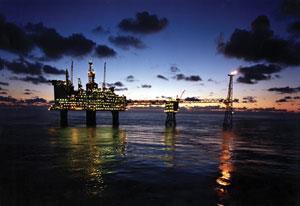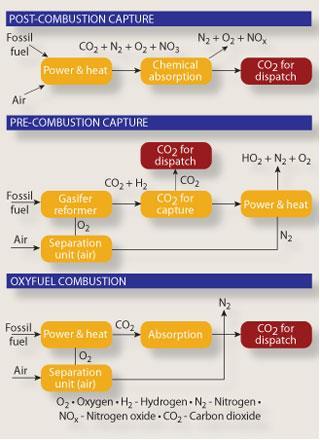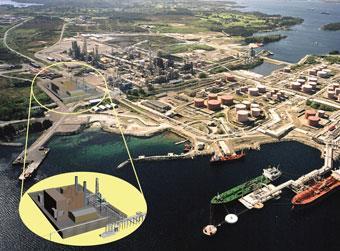Carbon capture and storage could allow us to burn fossil fuels without climate consequences - but only with more investment in R&D, argues Stuart Haszeldine
When fossil fuel is burned to make heat for electricity generation, the combustion of coal or gas produces carbon dioxide (CO2), a major greenhouse gas that is changing the Earth’s climate and acidifying our oceans.

Carbon capture and storage (CCS) is a suite of technical and chemical processes which allow CO2 to be separated, liquefied under pressure, and then transported by pipe for storage in porous geological rock formations, deeper than 800 metres beneath the seabed. Suitable geological sites may be depleted oil or gas fields, or salt water aquifers not already used for other purposes.
CCS can directly reduce CO2 emissions, enabling industrialised countries to continue using coal and gas for electricity generation while still meeting targets of 60 to 80 per cent reductions in CO2 emissions from power generation by 2050.
A vital link in this chain can be provided by chemists and chemical engineers. The most energy-consuming and expensive steps in CCS are the separation of CO2 from the combustion gases, and the purification of O2 from air to enable clean combustion. At present, these steps rely on circulating large volumes of solvents, using membranes with poor performance, or cryogenic methods. There is great scope for improving separation processes.
If CCS really is a key technology to reduce future CO2 emissions, we must make significant and rapid progress in three different sectors: technology, legislation, and business. The UK is amongst the most advanced nations in legislation, but still falters at the costs implied by these new technologies, so that business cannot see a clear profit route. Yet given the rate at which CO2 continues to pour into our atmosphere, the leverage of knowledge from these first CCS plants is likely to be amongst the cheapest long term investments to enable greenhouse gas reduction, not the most expensive.
Separation anxiety
A problem common to all CCS plants is the expense and energy cost of CO2 separation. Nitrogen makes up more than 80 per cent of the flue gas, but it must be removed because the cost of transporting and compressing unnecessary diluents before deep injection is prohibitive.
The most developed separation method relies on dissolving CO2 from post-combustion flue gas in a variety of amine solvents (such as methyldiethanolamine). These techniques have been established for decades in cleanup of natural gas, and can strip out over 90 per cent of CO2 very selectively. But a power plant would use a process 10 times the size of existing equipment. These solvents must work on flue gas, under conditions of atmospheric pressure, at 40 to 60°C, with low CO2 concentrations of 2 to 15 per cent, and high flow rates of 5 million m3/hr. A major problem for solvent life are combustion impurities: air pollutants such as SOx, NOx, particulates, and HCl, HF, mercury, and organic and inorganic contaminants. Consequently, commercial solvents contain cocktails of inhibitors and additives. Large fluid flows are also required, and solvent regeneration requires heating to 100-140°C, followed by compression to pipeline pressures of 100 bar. This all typically results in a 20 to 30 per cent increase in coal consumption at the plant.
However, a new technique called pressure swing adsorption relies on switching between high and low pressure to selectively adsorb and desorb CO2 on a molecular sieve, such as activated carbon or a zeolite. This can reduce the energy costs of solvent regeneration to 20 per cent of energy output. Membrane separation of CO2 has also been attempted, but energy penalties were greater than conventional solvents, and CO2 separation purity was poor.
Cheaper solvents are needed for post-combustion capture. One option may be the chilled ammonia process recently developed by French conglomerate Alstom. This builds on the experience of using anhydrous ammonia for NOx scrubbing, and claims to reduce the energy penalty costs from 30 per cent (for amine-based capture) to just 10 per cent. The process is fed 8 per cent CO2, runs at 1.6-4.5°C with 90 per cent CO2 removal, and can use low-grade waste heat for solvent regeneration. The cost is less than half of currently-used amine solvents per tonne of CO2. Demonstrations at 5MW scale have been made by We Power in Wisconsin. The chilled ammonia process is now being taken up experimentally by American Electric Power in a West Virginia coal plant from 2008; by E.ON with a 5MW trial in Sweden from 2008; and with a full-sized plant demonstration at an AEP plant in Oklahoma from 2011.
Pre-combustion separation is more attractive because of the higher CO2 concentration. This style of process is presently applied in ammonia and fertiliser manufacture, or as part of hydrogen production within oil refineries. But these processes still need a threefold scaleup before they can be integrated with a power plant.
First, the fossil fuel is processed with oxygen and steam in a ’reformer’ to produce a synthesis gas (’syngas’) of CO and H2. Further reaction of the CO with steam produces H2 in a shift gas reactor, delivering waste CO2 concentrations of 15-60 per cent at pressures of 2-7MPa, which can be captured by Selexol solvents (a mixture of the dimethyl ethers of polyethylene glycol). Such processes are planned for Integrated Gasification Combined Cycle (IGCC) coal combustion - which starts to look more like a chemical plant than a traditional power station, and can be set up to either produce hydrogen or to decarbonise fossil fuel.
If pre-combustion separations can be improved, this offers a very attractive combination of power plus chemicals. Several research avenues are active. Pressure swing absorption can remove CO2 to produce very pure H2, and at the University of Edinburgh a team led by Stefano Brandani is investigating metal-organic framework materials with ultra-high surface areas that are suitable for this purpose.
In the future, it may be possible to use a membrane to separate hydrogen from a one-step reforming/shift reaction, which would leave pressurised CO2 to be sent for storage. This would remove the energy penalties of compressing both H2 and CO2. The challenge is to ensure that sufficient H2 permeates through the membrane without it disintegrating, all with a high selectivity for H2 so that the CO2 stream exceeds 90 per cent purity to meet subsurface storage regulations.
Membrane materials under investigation have included perovskite oxides, palladium oxide microtubes, microporous silica, and gamma alumina (aluminium oxide with a spinel structure). The ultimate process may be the pyrolysis of methane, to produce H2 and black carbon - which can be stored as an inert solid. Kvaerner and Synergy Technologies of Canada have both claimed success with such plasma reactors without water or O2, but the process is endothermic.
A third method of capture is currently only in the demonstration phase. Burning fossil fuels in nearly-pure oxygen (so-called oxyfuel processes) eliminates atmospheric nitrogen from the process. This not only improves efficiency, it also produces a cleaner stream of carbon dioxide. Oxyfuel burners could be retrofitted to existing coal power plants (redesigned turbines are required for gas-fired plants), and the aspiration is to provide a cost-effective low CO2 option. The critical cost step here is to obtain cheap and reliable O2. Pure oxygen is normally produced by liquefying air, processes that are well-established but relatively expensive. Cheaper options could be provided by mixed metal oxide membranes with perovskite or brownmillerite structure, which allow only oxygen to pass through. These are being investigated for fuel cells by John Kilner at Imperial College London, while at the University of Newcastle, Ian Metcalfe’s team is investigating hollow tubes of the material LSCF, La0.6 Sr0.4 Co0.2 Fe0.8 O3- d , where d represents the oxygen vacancy within the lattice.
Leaky rocks
A common question is, ’will stored CO2 leak out’? Obviously there is no point in separating and burying CO2, if it merely returns to the surface within decades. This can be answered by looking to a geological argument, which points to the common occurrence around the world - in places as diverse as the North Sea, Italy and Colorado - of high concentrations of CO2 held in natural traps. This can be pure CO2, or up to 20 mole per cent associated with oil or methane gas. These accumulations have been retained intact for tens of millions of years. Crucially, the minerals (silicates or carbonates) which form the reservoir rock framework, and minerals forming the overlying seal of clay minerals or salt, have not been consumed to permit release of that CO2. The task is to explore the deep sub-surface to discover comparable settings, and to ensure that these are chosen as reliable disposal sites.

The UK has not historically been strong on CO2 capture research, but this month the Centre for Innovation in Carbon Capture and Storage (CICCS) opens at the University of Nottingham. CICCS plans to develop new ways to trap and store CO2 permanently and safely, bringing together engineers, mathematicians, bioscientists, geographers, geologists and end-users. It is funded to the tune of £1.1 million by the Engineering and Physical Sciences Research Council, which is also reviewing CCS funding proposals from the University of Edinburgh, and Queen Mary, University of London.
Several methods of CO2 sequestration into solid minerals have been proposed, but all suffer from fatal flaws - such as the energy used in preparation of the absorbent, or the difficulty of transporting and disposing of large volumes of solids.
One of the technologies that CICCS will work on uses a natural process in conjunction with silicate-based rocks such as serpentine, Mg3 Si2 O5 (OH)4, which is found in quantities sufficient to store all the CO2 produced by the combustion of the entire world’s known fossil fuel reserves. The CO2 from burning coal undergoes an exothermic reaction with the serpentine over a few minutes at 150-250°C, and binds the carbon dioxide to form magnesite, MgCO3, which can be used as aggregate for road building or shaped into bricks for construction. However nothing comes for nothing, and more sceptical commentators point out that the serpentine will need to be quarried or mined, processed, transported to the site of use, and the resulting products taken away. This creates a whole new chain of environmental impacts from the extraction of serpentine comparable to the opencast coal industry. And a by-product of the process can be huge volumes of silicic acid.
Legal eagles

On the face of it, the UK is playing a significant role in setting up the necessary legislation for widespread use of CCS. The London Convention Protocol (the principal legislation for global marine protection) was modified on 2 November 2006 to permit CO2 to be stored deep below the sea bed, a move that was led by the UK government.
On 26 June 2007, the OSPAR treaty (covering north-east Atlantic marine environments) was modified to ’allow all forms of carbon capture and storage in sub-seabed geological formations’ - once again, the UK government was behind this change.
This means that CCS is now legal in the offshore sedimentary rocks beneath the North Sea and Irish Sea. This gives the UK a great advantage in that the sites of CO2 production from coal power plants lie only 20 to 200 miles away from these storage sites. A suite of primary legislation will be brought to the UK parliament later this year to enable companies to license CCS projects, operate the facilities and then hand them over to government post-operation. On a national level, only Australia is ahead in this legislation, since California’s proposed legislation to enable CCS was withdrawn earlier this year.
The UK’s recent Climate Bill is the first in the world to commit a government to legally-binding CO2 reduction targets at five year intervals, forcing emission cuts of 3 per cent per year. But the Tyndall centre for climate change at Manchester has pointed out that even sticking to this plan carries a 60 per cent probability of exceeding 3°C warming over the coming century, considered by some to be a ’tipping point’ where no action could reverse the established warming trend. And it is hard to see how the UK CO2 reduction plan can be delivered without serious CCS deployment - after all, 30 per cent of the country’s emissions are derived from electricity generation.

Initial hopes for CO2 storage in the UK focused on the use of CO2 as a fluid to assist with enhanced oil recovery of 5 to 15 per cent of additional oil from offshore oilfields. This could produce very substantial tax revenues for the Treasury, and extend and diversify the lifetime of the important offshore sector of UK industries. However, to date, no successful proposal has emerged, and the time window for optimum engineering is slipping by. The next few years will be the last opportunity for a developer with vision, and deep pockets, to construct the required network of pipelines which can link power plant CO2 sources to deliver to a range of suitable offshore fields.
The UK had the opportunity to host the world’s first commercial-scale CCS plant. In its Energy White Paper in May 2007, the government announced a CCS ’competition’ to be launched in November. Companies would be asked to design a demonstration plant, to generate at least 300MW of carbon-neutral electricity, that could be operational by 2014. But on the same day the White Paper was unveiled, British Petroleum chose to very publicly withdraw its project from the CCS competition. It had planned to convert methane to hydrogen at a plant in Peterhead in Scotland, and use the CO2 generated to enhance oil recovery in the Miller oilfield in the North Sea. BP blamed their about-face on the government’s tardy timescale. Since 2005 the company had made clear statements about the viable life of the oilfield. But by the time the government had made its decision, it was too late to implement the plans (see Chemistry World, July 2007).
It can’t have helped that gas prices have increased greatly since the project was first conceived, and that the government has shifted its position to favour coal-fired applications. Nevertheless, the Peterhead project could have been a world leader, operational by 2009, if the Government had been ready for commercialisation. The world’s first full-scale CCS power projects are now more likely to be developed by 2012 in Australia or Canada.
A new hope
Nevertheless, 10 additional proposals for a CCS power plant have been made in the UK, all fired by coal or by petroleum coke. The main players are power companies E.ON, RWE, ConocoPhillips, Centrica, Scottish and Southern, Scottish Power and Powerfuel.
These propose a diversity of plant types. Some are integrated gasification combined cycle (IGCC) plants, which rely on efficiently capturing CO2 from coal as it is converted into a stream of combustible syngas. However, there are fewer than 10 of these new coal-fuelled plants worldwide.
Another proposal is for new coal-fired plants with integrated CCS, which would burn pulverised coal at high temperatures to produce supercritical steam. The boilers can also be retrofitted to upgrade existing power plants, and accept a wide range of fuels - including co-firing of biomass.

In Norway, Statoil and Shell have evaluated the possibilities of using CO2 separated from gas-fired plants to extract residual oil from a depleted field, and decided that it would not be profitable. However, a European CO2 test facility has gone ahead at Mongstad, near Bergen, to capture 100,000 tonnes CO2/year from a Statoil oil refinery.
In Germany, the government is considering an oxyfuel plant from energy company Vattenfall and an IGCC proposal from RWE; in France, Total is planning to store CO2 from the combustion of gas in pure oxygen at Lacq in southwest France; and electricity generator CEZ is proposing CCS plants in the Czech Republic, Poland, Bulgaria and Romania. These all contribute to the EU’s ambition for 12 operational plants by 2015.
Boosting business
It seems as though there is enough capital available to fund both new-build and retrofits of CCS to existing plants. But it’s also clear that no company can afford to run a CCS plant in an open electricity market, unless the EU emissions trading scheme provides revenue by setting a much higher and stable CO2 price of at least €15 per tonne.
The UK’s CCS competition, which aims to select a single winning technology, may divert attention from other equally plausible options. Rather than pooling all UK effort into a single project for capital assistance, several CCS technologies could be developed at once, and much more attention focused on how to enable power companies to make a long-term income from CCS. If the revenue is visible, then companies will borrow their own money to build the CCS plant, and need not use public funds.
The government could also add a stick to this armoury of financial carrots by creating an obligation to supply, at a slightly higher price, low-CO2 fossil-fuel electricity. If passed on at cost price, that would cost each middle-class household about £30 per year - a tiny amount compared with the potential costs of anthropogenic climate change, as outlined in the Stern review of the economics of climate change, released in October 2006.1
In case anybody is not yet entirely convinced about the impact of human activities on our climate, it would be worth reading a recent study by Michael Raupach of the Global Carbon Project at CSIRO in Canberra, Australia, and colleagues,2 which shows that world CO2 emissions are now above the most pessimistic predictions by the Intergovernmental Panel on Climate Change. And James Hansen, chief environmental modeler of NASA, has recently pointed out again3 that continuing our present activities unabated will melt enough ice to see sea level rises of several metres this century, spelling disaster for port cities around the world.
It will not be a nuclear plant, or renewable technologies such as wind or wave power, or even the first-generation CCS plants, which reduce world CO2. It will be the improved second-generation CCS that begins this process, and the standard deployment of third-generation CCS, by 2020 at the latest, which could make a real impact. By that stage we will surely know if it’s too late to avoid unprecedented and unpredictable effects in our living environment.
The age of CCS is about to start, and not a moment too soon.
Stuart Haszeldine is professor of geology at the Scottish Centre for Carbon Storage, University of Edinburgh, UK
References
- N Stern, The Economics of Climate Change: The Stern Review, Cambridge University Press, 2006, ISBN 9780521700801
- M R Raupach et al, Proc. Natl. Acad. Sci., 2007, DOI: 10.1073/pnas.0700609104
- J E Hansen, Environ. Res. Lett., 2007 DOI: 10.1088/1748-9326/2/2/024002






No comments yet